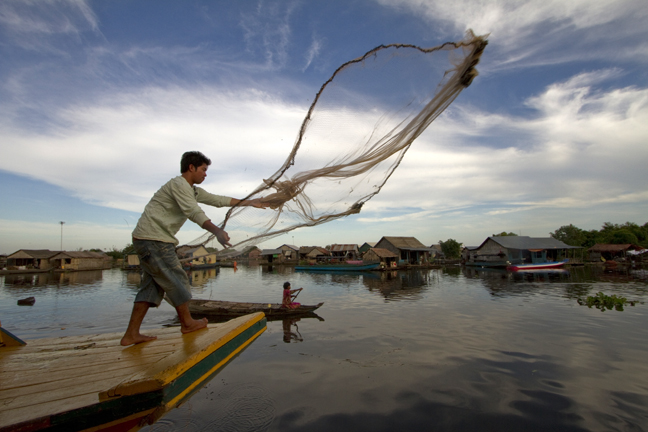The Tonle Sap, is the largest lake in Southeast Asia. It is located almost in the middle of Cambodia. Siem Reap is only 15 km to the north of it. When the water level is high enough, regular boat service is provided from Siem Reap to Cambodia's second largest city Battambang and, using the lake's outlet called Tonle Sap river, to the capital Phnom Penh.
Tonlé Sap literally means large river (tonle); fresh, not salty (sap), commonly translated to "Great Lake", refers to a seasonally inundated freshwater lake, the Tonlé Sap Lake and an attached river, the 120 km long Tonlé Sap River, that connects the lake to the Mekong River. They form the central part of a complex hydrological system, situated in the 12,876 km2 Cambodian floodplain covered with a mosaic of natural and agricultural habitats that the Mekong replenishes with water and sediments annually.

As one of the world’s most varied and productive ecosystems, the region has always been of central importance for Cambodia's food provision. It proved capable of largely maintaining the Angkorean civilization, the largest pre-industrial settlement complex in world history. Either directly or indirectly it affects the livelihood of large numbers of a predominantly rural population to this day.
One million Cambodians directly depend on this lake in living. 90% of those people have stilt houses constructed in the lake and 10% live in floating villages. Altogether there are 170 fishermen villages at the Tonle Sap. This lake is famous for its abundance in fish. It is the fourth largest source of fresh water fish in the world.

Fishermen can catch 300,000 tons of fish annually, 75% of Cambodia's freshwater fishing. More than 150 species of fish live in the lake. The biggest freshwater fish in the world, the Mekong giant catfish, grows to 250 kg. The biggest fine specimen ever caught here was 337 kg, the size of Jersey cattle. But this catfish species is almost extinct now. Altogether, about 60% of Cambodian population are affected by the Tonle Sap lake as it provides, besides fish, fresh water as well as fertile sediments for growing crops along the Mekong, Tonle Sap and Bassac rivers.

The main reason for the Great Lake's natural wealth is a unique annual phenomenon called the "return of the river". This means, the Tonle Sap river, connecting the lake with the Mekong river, regularly changes its direction. Usually, it is the outlet of the Tonle Sap lake, but in June it becomes an inflow of water to the lake. The reason is the flood of the Mekong river fed by snow melting in the Himalayas and heavy monsoon rainfalls at the same time. The increasing Mekong water level then reverses the flow of the Tonle Sap river.
Thereby the Tonle Sap lake is a natural buffer of the Mekong river system, avoiding too heavy floods in Cambodia's central plains. This return of the river supports the migration of Mekong fish, they come to the lake for spawning. The water level of this extraordinary inland lake rises 7 meters during the annual rainy season, after above-average precipitation even 9 meters. The minimum size of the Tonle Sap lake of 2,500 square kilometers then quadruples and can even reach 16,000 square kilometers.
Only Lake Chad and Lake Dongting with its outlet to the Yangtse river show larger variations in size. In October the Tonle Sap water starts flowing back to the Mekong. This annual event is celebrated in the capital Phnom Penh with boat races, the water festival is the most visited event in Cambodia.

When the water level drops to its minimum surface size, a 20-30 km wide band of inundating forest is left dry. This area is called "underwater forest", as the trees' trunks and parts of the crowns - and sometimes even whole trees - are flooded annually for a few month. This large inundate forest is of utmost significance as a breeding ground for the reproduction of fish. Accordingly, the laying egg season is from August to October. But the Tonle Sap freshwater swamp forest has been threatened by deforestation during recent decades. The Great Lake was designated as a UNESCO biosphere in 1997.
====
Source and reference : CPWF-Mekong | angkor-travels.com | THE STRATEGIC SIGNIFICANCE OF THE MEKONG By: Osborne, Milton



















